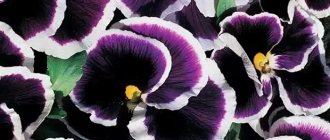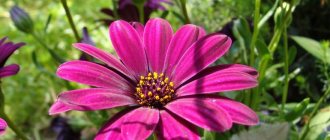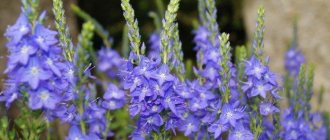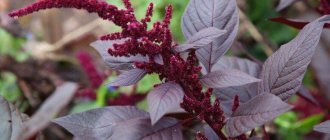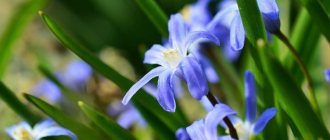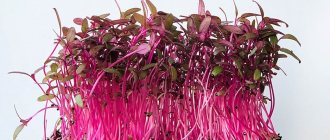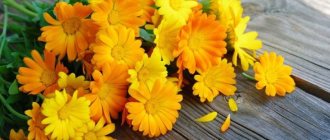general information
In the world, pansies are more often known as viola. And this garden culture has been known for many centuries, starting from the times of monastery gardens. Over time, hybrid forms appeared, and the most popular of them is the Wittrock viola.
Pansies have small, dark leaves with a serrated edge. The flowers are quite large, sometimes even up to 10 cm in diameter. They consist of four large petals, three of which look upward. But this is not the only form that exists.
Most often, the color of the upper and lower petals is different, and a contrasting eye is formed in the center. Depending on the conditions, pansies are grown as a biennial or perennial plant.
Photo: oir.mobi
Types of pansies
Even in the wild, there are several hundred varieties of pansies of all imaginable and unimaginable colors. It’s not for nothing that they are distributed all over the world, from the subtropics to the northern regions!
Fragrant pansies
This species is famous for its aroma and variety of blue and purple shades. It is this viola that is widely used in cosmetology and perfumery.
Photo: 9dach.ru
Horned pansy
A garden perennial that got its name because of the bizarre growth behind the bud. The height of the shoots reaches 25 cm, and the leaves are more elongated. The diameter of the flowers is generally about 5 cm.
Photo: viherkasvit.net
Monochrome pansies
All petals are painted in one uniform color. But veins, small spots or stripes on the lower petal are acceptable. Yellow and snow-white varieties are very popular.
Photo: pxhere.com
Two-color pansies
The most common category among gardeners is when the upper and lower petals are colored differently. It seems that all existing colors are found here.
Photo: pinterest.ru
Spotted pansy
Spots on buds and petals can be of several colors at once. There are decorative varieties with corrugated flowers. An excellent option for shady areas.
Photo: pixabay.com
Sororia
This variety is also called moth viola, and its fancy white and lilac petals really look like the wings of a moth. It is also a perennial with beautiful heart-shaped leaves.
Photo: prolisok.com.ua
Osteospermum (50 photos): types, planting and care in open ground
In cosmetology
The presence of astringent and anti-inflammatory components allows this herb to be successfully used by cosmetologists. It is good as a balm and compress for the treatment of seborrhea on the face and hair, purulent acne on the skin.
To obtain the medicine, bratchik grass is mixed with vegetable oil, obtaining violet oil, and problem areas are treated with it. After washing your hair, it will be very useful to rinse it with a decoction of this herb mixed with nettle, burdock or string.
This oil will soften sagging skin and have a rejuvenating effect.
Preparation of violets
When collecting violet raw materials, it is important not to confuse the field and tricolor violets; the field type has a slightly different composition. Collected when it blooms. All parts of the plant are suitable for cutting. It is scattered in one tier and dried in the fresh air or in a room with free access to air. The raw material smells faintly, characteristically, the taste is a little sweet with a feeling of viscosity. Dried herbs must be stored in a closed glass container. If it is not possible to collect violets yourself, you can buy them at the pharmacy.
Caring for pansies
Pansies prefer a golden mean in everything - in temperature, watering and lighting. Most varieties feel quite comfortable in our latitudes and do not cause problems.
Temperature
Ideal temperature conditions for pansies are 12-22 degrees. They survive short-term changes normally, but do not survive prolonged frosts and droughts well.
Photo: zen.yandex.ru
Lighting
With a lack of sun, the flowers become smaller, and with too much sun, pansies may stop blooming altogether. The ideal duration of bright light is 5-6 hours a day.
Photo: 56441938444431.my-6-sotok.rf
Watering
Seedlings and cuttings need a constantly moist substrate, but they should not be flooded to prevent them from rotting. Adult plants are watered with warm water as the soil dries, very carefully and strictly at the root. Leaves and flowers should not be wetted.
Photo: wallbox.ru
The soil
Ready-made soil for violets is best suited, especially when it comes to seedlings. In the garden, in the fall, we advise you to carefully dig up the area and, if necessary, apply fertilizer.
Photo: pinterest.ru
Fertilizers and fertilizing
Pansies like regular feeding every 2-3 weeks. Ready-made complexes for violets are still suitable, and in addition to them you can use fertilizers with phosphorus and potassium.
Photo: dobro.ru
Trimming
Old, growing bushes can be pruned, and at the same time cuttings can be used for propagation. And young bushes tolerate pinching well if you want to give them a more compact shape.
Photo: pxhere.com
Wintering
With the onset of cold weather, trim the bush, stop watering and fertilizing and cover the planting with spruce branches or leaves. This is how perennial frost-resistant varieties will survive the winter. At the beginning of spring, immediately remove the shelter so that the roots do not begin to rot.
Photo: florino.net
Marigolds (50 photos): types, care and planting in open ground
Interesting facts about violet tricolor
In Ancient Rus', brothers were a symbol of moderation and morality.
The violet was the personification of happiness for Josephine Beauharnais, Napoleon’s adored wife. Lovely flowers were constant companions of this couple's love story. They were nearby during the meeting of Josephine and Napoleon and decorated their wedding tent. Every anniversary, Josephine would find a small bunch of violets on her dressing table, a symbol of her husband's devotion and adoration. After Napoleon's death, two violets lay in his medallion next to his son's lock of hair.
According to old English superstitions, if you pick violets on a sunny day, a thunderstorm will soon form.
French and Polish young men present these flowers when parting.
In Ancient Greece, the violet was a symbol of sadness, but at the same time, according to another tradition, a violet wreath was placed on the head of a child on his fourteenth birthday, thus saying goodbye to childhood.
Legends about brothers
According to one legend, after a long wait, the faithful girl Anyuta turned into a violet, seeing off her fiance to the war, whom she never saw.
An Eastern legend says that Adam’s tears turned into pansies when the Archangel Gabriel told him that the Lord had forgiven his sins.
According to another legend, Apollo molested a girl whom Zeus saved by turning her into a beautiful violet. So it would have grown in heaven, far from the eyes of mortals, but the goddess Persephone, who was in heaven, abducted by King Hades, dropped the bouquet, and it fell to the ground.
In ancient Rome, violet tricolor was considered the flower of Jupiter. They had their own history of the origin of the flower. One sunny day, Venus was washing her body in a crevice, and, turning around, noticed that a pair of shepherdesses were watching her from behind a rock. Angry, she demanded that Jupiter kill the overly inquisitive boys. But Jupiter considered this too severe a punishment, and limited himself to turning the young men into big-eyed flowers, on which the surprise of the young tomboys froze.
Planting and propagation
The easiest way to propagate pansies is simple self-seeding. New seeds will germinate by the end of summer, and will just adapt and acclimatize by winter. There is only one drawback of this method - it is difficult to obtain a clear landing shape. But in the same way, you can sow the seeds yourself immediately after they ripen.
To achieve flowering as early as possible, pansies are planted as seedlings in February. Then the bushes will bloom in the coming summer, but as an annual. It is enough to slightly bury the seeds in loose soil, water and leave under the film. After just a couple of weeks, the seedlings can be harvested.
The seedlings are transplanted into open ground in May. It will have time to take root and bloom by summer. You should not pick off flowers either during or after flowering. However, this applies to any violets.
Pansies can also be propagated by cuttings. You need healthy tops with 2-3 nodes, which are buried about 5 cm into the ground and left in the shade. After 3 weeks, if there is sufficient moisture, they will take root. And if you plant them in May, by summer they will even bloom for the first time. Using the same principle, old overgrown plants are rejuvenated.
Photo: garden4therapy.wordpress.com
Preparing seeds for sowing
It is better to collect the seeds yourself, selecting plants from the most beautiful areas. The seed capsule is formed at the site of the flower, and at the moment of ripening it shoots out grains. You can’t pick it earlier, as germination will be zero.
Experienced gardeners put bags made of thin, breathable fabric over the heads, so they can collect seed from the best plants.
For good germination, it is recommended to process seeds collected by hand.
The drug Fitosporin is considered optimal; the preventive composition prevents the occurrence of fungal diseases when growing seedlings.
Before sowing, violet seeds are soaked in special growth stimulants. Zircon and Epin are considered the best. This kind of procedure increases the plant’s endurance and helps in the first stage of germination.
Preparation should be carried out strictly according to the instructions included in the packaging of the chemicals. After this, they are dried in air, having previously been distributed evenly over a smooth surface in a well-ventilated area.
Completely dry seeds are ready for planting. If storage is planned, place the crop in a fabric or paper bag, leaving air access.
Capacity
Different containers for viola seedlings are used; there are no special recommendations. It is permissible to take shallow plastic or wooden boxes, cardboard cups, and disposable tableware as containers.
Trays or cassettes for seedlings are purchased in specialized gardening stores. Blocks include from 4 to 300 cells of different volumes. It is optimal to use containers with a small volume of soil. The benefit of the cassettes is their convenience for the plant and the gardener. Each sprout is in its own cell and the root system is not damaged when planted. With this approach, each shoot receives an equal amount of heat, light and fertilizer. As a result, the seedlings are stronger and healthier.
At home, they use egg containers. Craftsmen make blocks for seedlings from plastic bottles.
The soil
Sow pansies in loose soil. The finished mixture is purchased at gardening stores. Before planting, it is advisable to check the acidity level of the soil. Violets prefer a pH of 6.5.
Litmus indicators are used for determination.
Experienced summer residents prepare the land themselves. There are several recipes for the most successful soil mixtures:
- peat, earth, sand, humus 2:2:1:2;
- turf soil, sand, humus 2:1:2.
When planting in soil with a high peat content, no additional fertilizer is needed. Fertilizing is carried out after the first shoots.
Viola is also sown on peat tablets. The method is considered successful and provides high germination. The tablet is soaked in water. After swelling, the seeds are laid out on the surface, lightly covered with soil. All the necessary microelements for growth and development are already inside. It remains to wait for germination.
There is no clear decision on the choice of soil. Each gardener determines the most suitable combination.
Sowing viola seeds for seedlings
Experienced summer residents begin growing pansies by preparing a soil mixture and seeds. After completing the work, treat the container with a fungal solution.
Sowing is carried out according to the following instructions:
- The prepared container is filled with drainage, then with soil.
- The soil mixture is lightly pressed and well moistened by spraying with a spray bottle.
- The seeds are distributed evenly over the surface; there is no need to deepen them.
- Spray the surface of the soil with seeds generously so that the sowing reaches the depth required for germination.
- The surface of the container is covered with cling film and placed in a dark place at room temperature.
Another method of sowing viola is planting it in the snow. The procedure for preparing soil and containers is similar to the usual method. Afterwards, a layer of snow is laid on the surface of the soil. Violets are evenly sown on it. The snow melts and draws the seeds to the desired depth.
Summer residents believe that the method of planting on snow provides plants with high immunity and frost resistance. This method also has a preventive effect.
Pest and disease control
Natural types of pansies rarely get sick, but selected hybrids are susceptible to fungus. The most dangerous problems are stem or root rot, which appear as rotting spots closer to the ground. Urgently remove diseased plants, dry the soil and sprinkle with crushed coal.
Less common are powdery mildew or rust. In the first case, a whitish coating appears, and in the second, red, lumpy spots appear. Removing damaged parts and treating with fungicides will help.
The most common pests of pansies are aphids, spider mites and slugs. Due to the invasion of aphids, the shoots gradually become deformed and die, the mite leaves a web, and slugs simply eat the planting. Remove pests mechanically, spray the plants with a soap solution, and use insecticides if necessary.
Photo: pixnio.com
Eschscholzia (60 photos): types, planting and care in open ground
Pansies – photo
Thanks to their fancy color, pansies always look fabulous and exotic. It's hard to believe that they are actually completely simple and unpretentious. Look how good they are in group plantings!
Photo: m.2gis.ru
Photo: wallbox.ru
Photo: m.fotostrana.ru
Photo: wallpapers.net
Photo: nevseoboi.com.ua
Photo: wallbox.ru
Photo: cvetyphoto.blogspot.com
Photo: tchudesa.ru
Photo: fotoload.ru
Photo: pxhere.com
Photo: zastavki.com
Photo: vaseninasu.blogspot.com
Photo: kartinki-cvetov.ru
Photo: pixabay.com
Photo: ru.wallpaper.mob.org
Photo: funart.pro
Photo: eldomo.ru
Photo: plodovie.ru
Photo: nat-geo.ru
Photo: zen.yandex.by
Photo: funart.pro
Photo: proprikol.ru
Photo: cvetkoffandbuketoff.ru
Photo: wallbox.ru
Did you like the post? Subscribe to our channel in Yandex.Zen, it really helps us in our development!
Healing properties of Violet tricolor
Thanks to this rich content of productive elements, tricolor violet is endowed with anti-inflammatory properties. This is explained by the content of biological essential oil and mucous substances in the foliage and stems of the flower, which have an antiseptic effect on the functioning of the gastrointestinal organs. Thanks to them, the secretion of the pulmonary tract is enhanced and the removal of sputum is facilitated. Saponins found in the plant have a bronchodilator and diuretic effect.
When using violet preparations, in addition to relieving inflammation, you can observe an antispasmodic effect and the outflow of bile.
